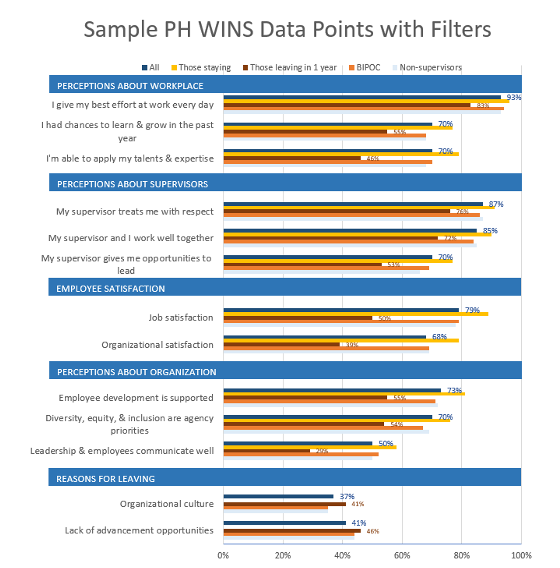The workforce spoke through the Public Health Workforce Interest and Needs Survey (PH WINS). If your agency hasn’t taken action already, now is the time. From the perspective of a former health department employee currently with the Association of State and Territorial Health Officials (ASTHO) supporting health departments, this blog outlines six practical uses of PH WINS for leaders, workforce, and human resources teams. First, two key points to consider:
Recognize PH WINS is reliable, generalizable data.
PH WINS data is weighted to account for non-response at the agency and individual level, and it offers a reliable, generalizable sample for health departments, allowing health agencies to use the findings without requesting their workforce provide more data.
Take more action than surveys.
Survey fatigue is real, especially when little to no perceived action takes place as a result. Take more action and communicate about it to all levels of staff at multiple points in time. Visuals help!
Here are six practical ways to use PH WINS.
- Ensure you have the staffing, resources, and time commitment in place for your workforce. Workforce directors and leadership are essential partners to each other. Make certain your agency has adequate staffing to address workforce issues proactively and responsively. Encourage your agency to set up periodic interactions (at least quarterly) between workforce leaders, agency leadership, and HR to prioritize and support key actions.
- Check your agency data and break it down. Use the data to identify differences between your employees who plan to stay vs. leave. The sample chart shows ways your agency dashboard can be filtered to examine how the data differs among those planning to leave in one year, by race/ethnicity, by age, or other criteria. Consider using the filters to help your agency identify its own priority indicators to improve retention and care for your workforce.
- Use PH WINS to prioritize your greatest asset: your workforce. Use the data points to justify activities to mitigate employee burnout and improve retention, especially of high potentials and high performers. Include workforce related priorities in your strategic priorities and plans, and to justify resources including staff time and funding to support your workforce. Depending on who you are talking with, focus on a few key points to make it more memorable and digestible, leaving other points as reference data.
- Use PH WINS to supplement your workforce training needs assessment and workforce development plan. No matter where you are in your assessment cycle, incorporate your agency-level findings on training needs into your professional development offerings.
- Use PH WINS data to support supervisors. Supervisors carry heavy responsibilities to care and ensure their team members’ success, but are not always equipped to do so. If you haven’t already, start by identifying one measure to focus on improving from the “Perceptions about Supervisors” data, found within the “Engagement & Satisfaction” topics. What supports might help supervisors improve? How can your agency help supervisors learn more about why team members may have rated those measures low or high, to inform actions moving forward? For example, the survey assesses whether and how much supervisors give their team members an opportunity to lead. Consider suggesting that supervisors and teams select at least one small opportunity per performance period for each team member to take a lead – with support before and during the project, and followed by a debrief conversation about what went well, what might go differently, and how to help in the future.
- Use PH WINS to improve agency communication. Justify additional communications support to increase regular communication between and among leadership and employees through existing tools such as internal newsletters, intranet or email, video messaging, or meetings.
Need more ideas? Post on peer networks and look at existing resources and the organizations that provide them.
Liljana Baddour, MPH, Association of State and Territorial Health Officials





